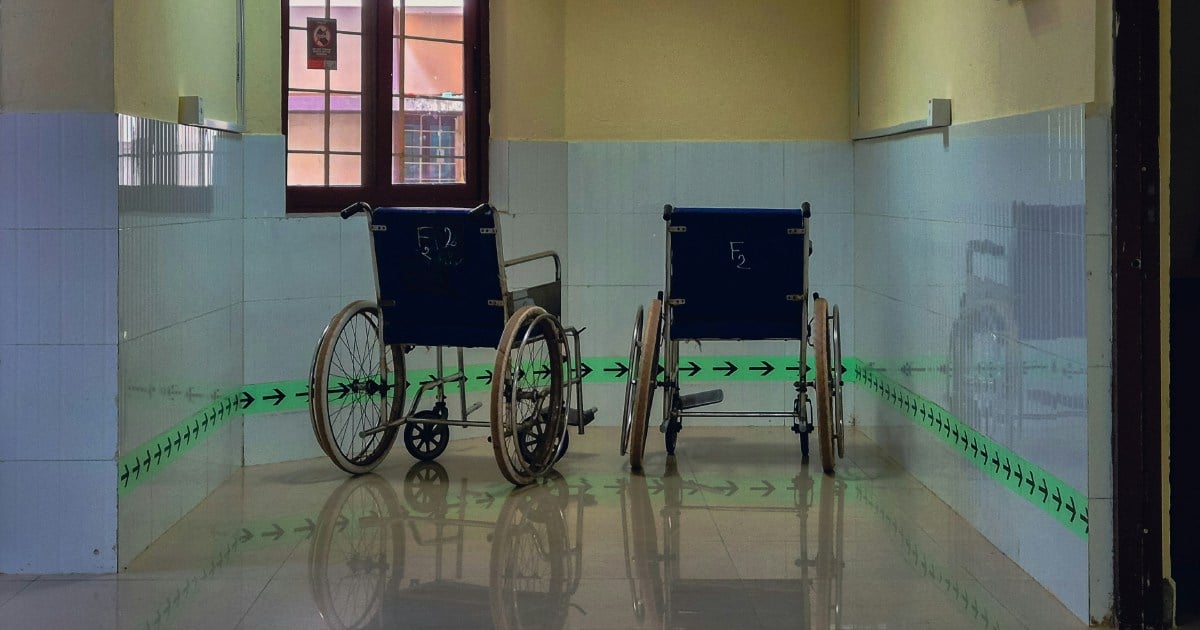IN the first week of March 2022, 12-year-old Lee Mun Hei was at the end of a brief reprieve.
His pelvic cancer had already been assaulted by rounds of chemotherapy and surgeries, but the metastases returned too fast.
By then, hospital stays had become routine. At his last admission, the doctors focused on one thing: easing his pain.
Throughout his illness — from the first diagnosis to the harrowing final months — his physical suffering was managed as best as possible.
But now, at the end of his life, Mun Hei had one wish: to die at home. The floods, however, had other plans.
The Klang Valley was drowning; drains were clogged, roads submerged. And so, as the waters rose outside, Mun Hei remained trapped in the hospital, longing for home.
Paediatric palliative care is often misunderstood as giving up, but for specialists like Dr Chong Lee Ai and Dr Farah Khalid, it’s the opposite.
It isn’t just about managing pain, but about helping children live fully, even when their time is short.
Says Dr Chong: “It’s about giving them moments that matter, not leaving them in bed waiting to die.”
“From just talking with him, we knew Mun Hei was a precocious bright boy. He was always thinking,” recalls Dr Farah, adding: “He talked about everything — from the universe to philosophy to art. He drew beautifully and dreamt big dreams.”
With Mun Hei, this meant creating small pockets of joy in the midst of suffering. In the two weeks before he died, the team would wheel him out of bed to play his favourite card game, Uno.
“We’d get a wheelchair that could recline and take him down to the aquarium at the hospital where we’d imagine we were deep in the ocean,” shares Dr Chong.
Laughing softly, she adds: “We’d hide behind some plants and Dr Farah would pretend to be a gorilla!”
The two women break into laughter at the memory.
For Dr Chong and Dr Farah, these were not just diversions, but essential acts of care. They were helping Mun Hei hold on to pieces of childhood — curiosity, laughter, wonder — even as the illness took so much away.
LIFE-ENHANCING CARE
Dr Chong and Dr Farah, paediatricians based at Universiti Malaya Medical Centre (UMMC), are not what you might expect.
Their warmth, easy laughter and playful banter stand in sharp contrast to the weight of their work, where they’re surrounded by pain, grief, hopelessness and despair almost every day.
“Palliative care is a popular field!” quips Dr Farah, wryly, adding: “There’s just a long line of physicians wanting to get into palliative care!”
The reality, of course, is different. Paediatric palliative care isn’t a widely sought-after field. It demands far more than medical knowledge.
Practitioners need immense flexibility and the ability to think creatively, often challenging established systems and mindsets about managing incurable diseases.
More than anything, they need heart — deep compassion, the capacity to truly feel for their patients, connect with families and build trust.
One case involving grieving parents and their premature baby in the neonatal Intensive Care Unit (ICU) captures this deeply.
The baby was dying, and while an aunt urged the parents to “forget” and avoid sadness by not taking photos, the mother desperately longed for something to hold on to.
“The palliative care team discreetly created a private space, helping the mother take photos and a video as she sang to her baby,” shares Dr Chong.
That small but profound act honoured the mother’s need to remember — to acknowledge her child’s brief life and her own role as a mother.
But it’s not all about dying. Palliative care, insists Dr Chong, is about living.
“Palliative care is for anybody with a serious illness or life-limiting diagnoses and it can start early so we can help them live a good life,” she explains, adding:
“It’s about asking how you can live with your disease or illness and still live well. That is what many people don’t understand.”
Continues Dr Farah: “Although many people think of us as the harbingers of death, in reality, doctors like us aim to maximise quality of life, especially when that life is likely to be shortened.”
In Malaysia, paediatric palliative care is still in its early stages. According to the Health Ministry, an estimated 80,000 children in the country are living with life-limiting or life-threatening conditions and would benefit from some form of palliative care.
Yet, specialist services remain limited and are mostly concentrated in major urban centres. Outside these areas, access is scarce, and many children are referred too late to receive the full benefit of early intervention.
For too many of them, death will most likely happen amid the fluorescence and thrumming machinery of an intensive care unit.
At UMMC, the Paediatric Pain and Palliative Care Unit works closely with other disciplines to care for patients.
Yet there was still a gap — a need to go beyond medical treatment and offer more comprehensive support for families.
This led Dr Chong and Dr Farah to establish MyStarfish, a non-profit dedicated to providing holistic care and support for children and their families.
“We wanted to do more for our children and ensure the standard of palliative care matches what we were trained to provide,” shares Dr Chong.
Through donations, MyStarfish hires clinical psychologists, music and play therapists, and soon, an art therapist.
The funds are also used to buy toys and gifts to make the hospital experience less frightening for children.
Explains Dr Farah: “Most kids hate hospitals and the procedures are often painful. We try to make things more fun like celebrating birthdays, giving toys and using play in therapy and communication. A simple game can break the ice and help a child open up.”
PLACE OF REFUGE
Childhood illnesses are many and varied, as are the ways young bodies respond to them, so accurate prognoses can be difficult to make. Children’s physical, emotional and spiritual needs are not the same as those of adults.
Their families also require more support. What parents and siblings have to process — the decisions made, the grief that ensues — tend to be far greater and more complicated when a child is dying.
This is why a dedicated centre rooted in evidence-based palliative care is so urgently needed — a place where therapy, play and counselling are readily available while being connected to a major hospital for medical continuity.
Now, there’s finally a glimmer of hope.
The MyStarfish Children’s Palliative Care Centre will soon have a home in Section 17, Petaling Jaya. Thanks to the generosity of the Petaling Jaya City Council (MBPJ) and Mayor Mohamad Azhan Md Amir, a building has been offered for a 10-year rent-free use to bring this vision to life.
The centre will be designed, says Dr Chong, not just for the children but for their entire families. Parents, often exhausted from round-the-clock caregiving, will have a safe space to pause, breathe and find support.
Siblings, who are sometimes overlooked in the whirlwind of illness, will have access to counselling to help them process their emotions and fears.
For the children, play and music therapists will be available to create moments of joy and expression, helping them cope with pain and anxiety in ways words often cannot. It will be a place where families are cared for as a whole, not just as patients.
The service will be completely free, emphasises Dr Farah.
“Families already carry so much. They should never have to carry the cost of care too.”
NO ORDINARY CALLING
For Dr Farah, medicine was always the dream. “I decided I wanted to do medicine back in secondary school and there was honestly no plan B,” recalls the 47-year-old, smiling.
Continuing, she shares: “When they asked me in the interview why I wanted to do medicine, I gave the standard answers about wanting to help people. But really, there was nothing else I wanted to do. This was the only path I saw for myself.”
Going into paediatrics was, for Dr Farah, a natural choice.
“It was the best decision I ever made,” she says firmly. Palliative care, however, was something she found herself drawn to unexpectedly. “I was doing ICU, which is quite the opposite of palliative care,” she explains.
It was one little boy who changed everything. He was 6, battling a brain tumour, and had been in the ICU for six weeks.
Shares Dr Farah: “Looking back now, I think he was already dying. But we didn’t see it. We kept tweaking the drugs, feeling pleased when we got his oxygen levels up, thinking we were helping.”
The turning point came when his mother quietly asked if his siblings could visit.
“He was so close to them,” Farah recalls. “That’s when it hit me — we hadn’t even talked about this. ICU rules were strict, and he hadn’t seen them for weeks.”
Later, Dr Farah learned from his mother that he loved the outdoors and the sun. “And there he was,” she says, “in a room at the back of the ICU, far from the light”.
It changed the way Dr Farah saw medicine. “I realised then that there’s more to caring for children than fluids, medications, ventilators and keeping their hearts beating,” she reflects, adding: “There’s who they are, what they love and how they want to live — even at the very end.”
Like Dr Farah, 56-year-old Dr Chong’s path into medicine also began with paediatrics.
She recalls: “I kind of always knew I wanted to do medicine. And very quickly, I also knew I wanted to go into paediatrics. Working with children just felt natural to me.”
Then came an unexpected turn — a training position in paediatric oncology opened up.
“I didn’t mind oncology during my paediatric training, so I went for it,” she says. What followed were seven intense years in oncology, years that would change the way she understood medicine and care.
“I saw a lot during that time,” Dr Chong says softly. “And I realised we need to do more for the children we cannot cure, and for those who endure so much just to get through treatment. That’s when I began to understand the true importance of palliative care.”
REAL STORIES
There was the case, they recall, of an angry father and how, as doctors, they struggled to tell him that his 15-year-old daughter, diagnosed with bone cancer, wasn’t getting better.
“She was always screaming, always in so much pain,” Dr Chong remembers. “No matter how much analgesics you give, sometimes you just cannot get on top of the pain.
“Later, through palliative care, we learned there’s often much more driving pain than just damaged nerves or tissue.”
Adding, she says: “I think we had to break it to him that she wasn’t improving. And this man… he was huge, and we were like, how do we tell him? How do you be compassionate while delivering news like that?”
Dr Chong brought Dr Farah along. “She could lighten the mood and make the conversation less heavy,” muses Dr Chong.
In the end, the father wasn’t angry with them. Explains Dr Farah: “He was angry at the situation. There was no control, no way to fix it. That’s the lesson we learned — parents react the way they do for a reason. It’s not personal. The question is how we can help them cope with the circumstances they’re in.”
Cases like hers taught the team some of their hardest lessons. The pain is never just physical. It’s emotional, psychological and deeply tied to the family’s struggle to cope.
For parents, too, there’s often little support. While treatment focuses on curing the disease, families are left to figure out everything else on their own.
That’s where a specially designed palliative care centre can come in. It would be a place built to support not just the child, but the entire family, offering care, comfort and guidance when they need it most.
“All our patients are our teachers,” Dr Farah reflects, adding: “We learn so much from them. We see them and sometimes we realise how little we actually know.”
Adds Dr Chong: “I think they’ve taught me to listen. To listen more and to ask the right questions, because there’s always a story behind every patient. It depends on how much time you’re willing to spend understanding who they are and where they’re coming from.”
Each child carries more than a diagnosis. They carry a life — their quirks, their dreams, their fears and the people who love them. Behind every chart and scan is a family holding on to hope. It’s these stories that shape the way Dr Chong, Dr Farah and their team approach palliative care.
When Mun Hei lay dying on his hospital bed, far from home, he told his mother softly, “Don’t worry, I’ll be fine… but just remember me.”
To his father, he asked for one last favour — to download all his photos from his devices so he wouldn’t be forgotten.
As the centre takes shape, every story like Mun Hei’s has contributed to its vision. Through its work, his wish to be remembered will be fulfilled.
“Palliative care is about living,” says Dr Chong quietly, adding: “It’s about making sure that even when a cure isn’t possible, a child’s life and their story still matter.”
For details on ways to support, visit www.mystarfish.org.my.
© New Straits Times Press (M) Bhd






